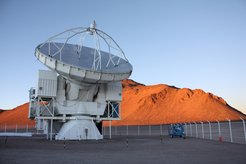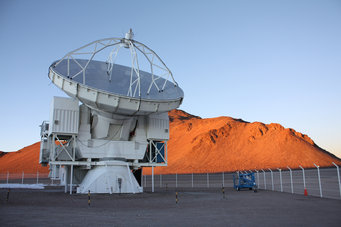
Latin America
Expanding relations and collaborations
In terms of the future of the Latin American subcontinent, education and research have been playing an increasingly central role since the start of the 21st century, which is also reflected in the Max Planck Society’s research collaborations with research institutions throughout Latin America: whilst the roots of these go back to the 1950s, official collaborations only developed gradually. Many countries within the region are currently showing a keen interest in the Max Planck Society and its Institutes as well as in its expertise in building and operating world-leading research facilities.
The fact that collaboration between Latin America and the Max Planck Society has been consolidated to a significant degree is not only evident from the increasing number of Latin American scientists doing their doctorates at Max Planck Institutes or else doing their post-doctoral research there, but also in the foundation of the partner institute in Buenos Aires, the partner laboratory in Rosario, Argentina, and the establishment of some 50 associated research groups. Currently, for example, there are in excess of 15 partner groups and over 15 independent / tandem groups at universities and research institutes on the subcontinent. In 2023 more than 700 Latin American guest and junior scientists are currently doing research at Max Planck Institutes. There are also about 200 research projects currently being run between Max Planck Institutes and regional partners.
Collaboration instruments
Examples of the outstanding collaboration instruments being used in Latin America include the CONICET-MPG Partner Institute for Biomedical Research in Buenos Aires (IBioBA), which conducts research into the principles and mechanisms of cellular and molecular biology in biomedicine, and the Max Planck Institute for Biophysical Chemistry (Rosario)’s partner laboratory (LMPbioR), which studies neurodegenerative diseases such as Alzheimer's and Parkinson's.
Thanks to the support of the Max Planck Society and its partner institutes, there are currently also about 50 research groups in Latin America associated with various Max Planck Institutes, which were founded either as partners or independent / tandem groups. The former are headed up by outstanding junior scientists who establish research groups in their countries of origin following a post-doctoral stay at a Max Planck Institute. Tandem and independent research groups involve a partnership between a host institute in Latin America and a Max Planck Institute, whose purpose is to conduct research into a topic of common interest and whose group leader is selected through international calls for applications and a joint evaluation process.
Symposia and international events
Given the continuing expansion and acceleration of international research, many scientists, particularly in low-income countries, can find it difficult at times to keep up with developments in the latest research topics around the world and in a timely manner. Therefore it is important to identify potential synergies between researchers in Latin America and in Max Planck Institutes and to realize them through bilateral research workshops and symposia in Latin American countries. By meeting face-to-face and presenting their latest research results to one another, information exchanges between and the education and training of junior scientists can become more concentrated and new joint projects and initiatives can be developed.
Calls for joint research project proposals
National funding agencies in various countries including Argentina, Brazil, Chile, Costa Rica and Uruguay, regularly organize joint calls for projects between Latin American researchers at different stages of their careers and their colleagues at the various Max Planck Institutes. These research projects are funded by the national funding agencies, but also by the respective ministries for research and technology or regional research foundations.
The roots of collaboration
Although the history of the Max Planck Society’s collaboration with Latin American partner institutions goes back a long way, official collaboration only actually began with the founding of the CONICET-MPG Partner Institute for Biomedical Research in Buenos Aires in 2011, since which time, it has continued to develop.
Whilst researchers were particularly interested in the subcontinent’s special geographical, biological and social diversity during the 1950s and 1960s, Latin America's social development was dominated by military dictatorships between 1965 and 1985: the preoccupation with domestic problems and foreign debt barely left any scope for international research collaborations.
Not until the democratic transition in the 1980s and the accelerated pace that resulted from globalization was the role of science and technology in the development of Latin American countries discussed once again, the result of which is that, when it comes to the future of the subcontinent in a globalized world, science and technology are central considerations.
Early encounters with Latin American researchers
Some 40 percent of the currently serving Max Planck Institute Directors are foreigners, some with Spanish and Latin American origins. But early encounters between Max Planck Institutes and Latin American researchers were rather sporadic. Argentinian physicist Dr Silvia Braslavsky, for example, set off in 1976 and made her way via the USA to the then Max Planck Institute for Radiation Chemistry in Mülheim, where she became a group leader. In 1969, Dr Thomas Jovin became the first Latin American researcher to be appointed Director of a Max Planck Institute, in this case the Institute for Biophysical Chemistry in Göttingen.
The Spaniard Manuel Cardona was appointed founding Director at the Max Planck Institute for Solid State Research in Stuttgart in 1971. Right from the start, Cardona has been a committed sponsor of the material sciences, not only in his home country, but especially in Latin America.
Professor Florian Holsboer, Director of the Max Planck Institute of Psychiatry in Munich, played a pioneering role in terms of research collaboration with Argentina. His Institute has maintained close relations with researchers in Argentina for over 20 years, and has played a central role in establishing the CONICET-Max Planck Partner Institute for Biomedical Research in Buenos Aires.
Special research opportunities
Countries in Latin America are not only characterized by very special geographical conditions, but also by their unique biological diversity and pronounced cultural diversity. Compared with Germany, their populations are much younger on average, which is why these countries are home to a large pool of well-educated, highly motivated and extremely talented students and junior scientist.
- ATTO
South America is also home to the largest existing tropical forest area on earth in the Amazonian region. As early as the 1960s, the then Max Planck Institute for Limnology in Plön (now the Max Planck Institute for Evolutionary Biology) established a tropical ecology research station in Manaus in collaboration with the Brazilian National Institute of Amazonian Research (INPA). The Max Planck Institute for Chemistry and the Max Planck Institute for Biogeochemistry are currently carrying out ecological and atmospheric research there at the Amazonian Tall Tower Observatory (ATTO) in Manaus, where, among other things, a climate measurement tower, with an altitude of over 300 metres, has been in operation since 2015.

- APEX
The high plateaus and deserts in the Chilean Andes are an ideal location for high-power telescopes that need clear skies and dry air, which is why, on the Cerro Paranal in Chile, work commenced in the 1990s on the construction of various large telescopes (VLT, VLTBI, etc.) for the European Southern Observatory (ESO). The Atacama Pathfinder Experiment (APEX), which was set up on the Chajnantor Plain in Chile's Atacama Desert in 2003 under the auspices of the Max Planck Institute for Radio Astronomy, was an important technological prototype for the ALMA large telescope, which has been in operation since 2013.
- CTA
The southern hemisphere’s Cherenkov Telescope Array (CTA) will also be erected in the Atacama Desert, one of the driest and most isolated regions on Earth (and therefore a stargazer's paradise), less than ten kilometres south east of the European Southern Observatory's (ESO) existing Paranal Observatory. The grid in the southern hemisphere will cover the CTA’s entire energy range and will detect gamma-ray energy from 20 GeV to 300 TeV. The plan is to install a much larger grid of all three classes of CTA telescope at the same location over an area of four square kilometres: this will include four large telescopes to record the CTA’s low-energy sensitive, 25 medium-sized telescopes to cover the CTA’s nuclear energy range, and 70 small telescopes to cover the CTA’s highest-energy gamma rays. The Max Planck Institutes for Physics (Munich) and for Nuclear Physics (Heidelberg) have a substantial involvement in the CTA.
